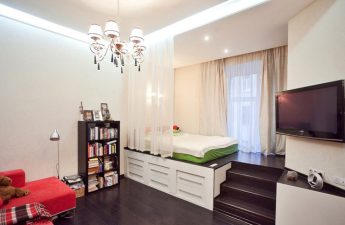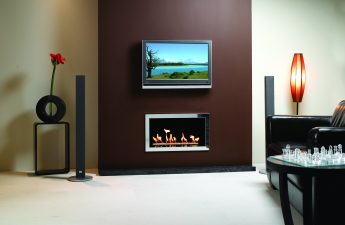The use of decorative stone in the interior allows you to create the illusion of the kingdom of nature. Various combinations of colors and styles make such an interior very original and aesthetic.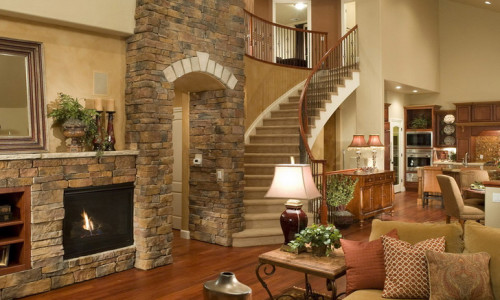 The use of artificial stone givesthe ability to add a certain charm to the interior of the room. Modern developments in the direction of creating artificial substances allow replacing natural materials with a high degree of reliability. Both in appearance and in many of their properties, such materials even surpass the original. The use of artificial coating in the interior is fashionable, modern and beautiful.
The use of artificial stone givesthe ability to add a certain charm to the interior of the room. Modern developments in the direction of creating artificial substances allow replacing natural materials with a high degree of reliability. Both in appearance and in many of their properties, such materials even surpass the original. The use of artificial coating in the interior is fashionable, modern and beautiful.
Features of artificial coating
Artificial stone is a durable, hard material that imitates natural stone. There are currently many varieties of such materials. The most common are:
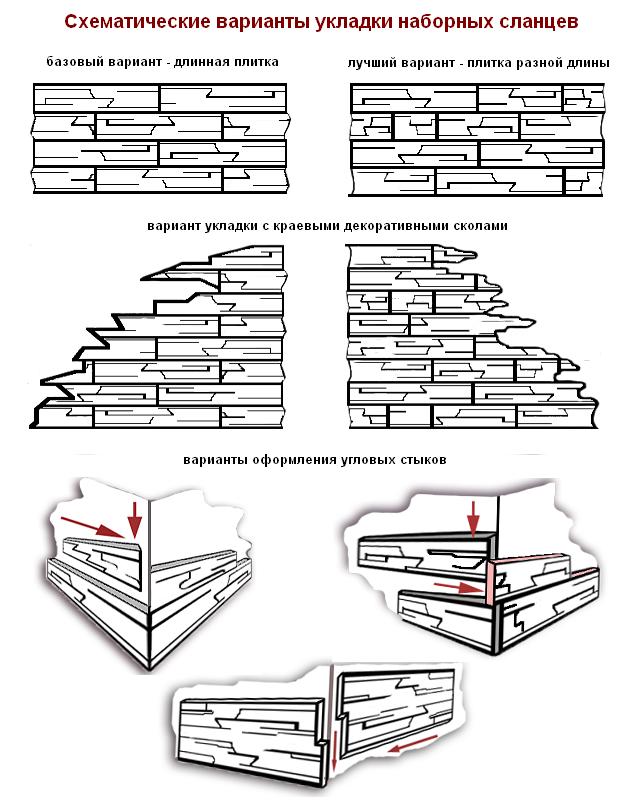 Scheme of wall finishing with decorative stone.With the help of such artificial materials it is possible to visually repeat the structure of granite, marble, limestone, coral and other valuable natural materials. Artificial tiles based on colored concrete are widely used. To increase strength, such a material usually has internal reinforcing elements in the form of fiber. These elements can be made of steel, fiberglass or polymer fibers. In order to increase authenticity, concrete is artificially aged using soot or iron oxide. The effect of aged stone can be created by rubbing soil or moss into the micropores of artificial tiles. One of the best substitutes for natural stone is quartz agglomerate (quartz stone). In terms of strength, it surpasses many natural materials. Agglomerate is a quartz composition (up to 95% by volume), into which a binding polymer resin (5-7%) is introduced. Such material retains the hardness and strength of quartz, but does not have microcracks and other defects inside due to the presence of a polymer filler. The heat resistance of the material is extremely high. In particular, artificial quartz stone containing 91-93% quartz, 7-9% polyester resin and dye is recommended. Such a coating is implemented in standard slabs with a size of 144x306 cm. Return to the table of contents</a>
Scheme of wall finishing with decorative stone.With the help of such artificial materials it is possible to visually repeat the structure of granite, marble, limestone, coral and other valuable natural materials. Artificial tiles based on colored concrete are widely used. To increase strength, such a material usually has internal reinforcing elements in the form of fiber. These elements can be made of steel, fiberglass or polymer fibers. In order to increase authenticity, concrete is artificially aged using soot or iron oxide. The effect of aged stone can be created by rubbing soil or moss into the micropores of artificial tiles. One of the best substitutes for natural stone is quartz agglomerate (quartz stone). In terms of strength, it surpasses many natural materials. Agglomerate is a quartz composition (up to 95% by volume), into which a binding polymer resin (5-7%) is introduced. Such material retains the hardness and strength of quartz, but does not have microcracks and other defects inside due to the presence of a polymer filler. The heat resistance of the material is extremely high. In particular, artificial quartz stone containing 91-93% quartz, 7-9% polyester resin and dye is recommended. Such a coating is implemented in standard slabs with a size of 144x306 cm. Return to the table of contents</a>
Features of stone on a concrete basis
 Decorative stone laying scheme.When choosing artificial stone for the interior, an important parameter is the ease of its processing by yourself. Artificial stone based on colored concrete and gypsum can be safely classified as easily processed materials. Gypsum tiles are easy to cut and have a low specific gravity. Weight reduction can be an important factor when it is necessary to glue the stone to a vertical surface. In appearance (taking into account the wide range of colors), you can choose an imitation of almost any natural stone. In addition, if the color does not satisfy the consumer, you can buy white material and paint it in any desired color. Insufficient moisture resistance of such materials is corrected by introducing polymer fillers or protective coatings into their composition. Such stones are sold as gypsum polymer artificial stones. In addition, water resistance is increased by impregnation with acrylic varnishes. At the same time, such impregnation also protects against pollution. Return to the table of contents</a>
Decorative stone laying scheme.When choosing artificial stone for the interior, an important parameter is the ease of its processing by yourself. Artificial stone based on colored concrete and gypsum can be safely classified as easily processed materials. Gypsum tiles are easy to cut and have a low specific gravity. Weight reduction can be an important factor when it is necessary to glue the stone to a vertical surface. In appearance (taking into account the wide range of colors), you can choose an imitation of almost any natural stone. In addition, if the color does not satisfy the consumer, you can buy white material and paint it in any desired color. Insufficient moisture resistance of such materials is corrected by introducing polymer fillers or protective coatings into their composition. Such stones are sold as gypsum polymer artificial stones. In addition, water resistance is increased by impregnation with acrylic varnishes. At the same time, such impregnation also protects against pollution. Return to the table of contents</a>
Surface preparation for laying artificial stone
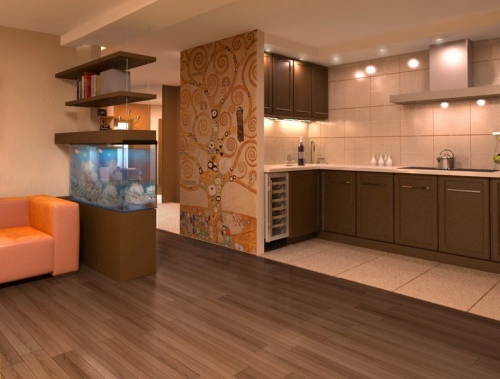 Figure 1.The most popular option for interior design is to use decorative stone for facing the entire wall or a large part of it. Laying decorative covering in the interior should begin with preparing the wall surface where it is planned to be installed. The wall (ceiling) surface should be perfectly flat at the point where the artificial stone is to be attached. In addition, artificial tiles are quite heavy: the interior element where the stone will be attached must be strong and stable. It is advisable to cover the area where the artificial stone is to be installed with a layer of plaster (putty) with the reinforcing mesh attached. The surface is ideal for decoration with artificial stone if it is faced with plasterboard. Preparation for the installation of artificial stone includes the development of a detailed interior plan. If necessary, supports and height limiters are installed and masked. Special corners can be used for such purposes. Return to contents</a>
Figure 1.The most popular option for interior design is to use decorative stone for facing the entire wall or a large part of it. Laying decorative covering in the interior should begin with preparing the wall surface where it is planned to be installed. The wall (ceiling) surface should be perfectly flat at the point where the artificial stone is to be attached. In addition, artificial tiles are quite heavy: the interior element where the stone will be attached must be strong and stable. It is advisable to cover the area where the artificial stone is to be installed with a layer of plaster (putty) with the reinforcing mesh attached. The surface is ideal for decoration with artificial stone if it is faced with plasterboard. Preparation for the installation of artificial stone includes the development of a detailed interior plan. If necessary, supports and height limiters are installed and masked. Special corners can be used for such purposes. Return to contents</a>
Wall cladding with decorative stone
 Figure 2.The doorway should be finished with artificial stone from top to bottom. Using decorative stone to cover the entire wall or a large part of it is a common option for interior design. Fig. 1 shows an example of such use of artificial stone for a hallway. Making a wall with an artificial stone covering includes several basic operations. The wall surface, prepared in advance for interior decoration, should be primed with an adhesive solution and a reinforcing mesh with a cell of approximately 5x5 mm should be fixed to it. Horizontal marking of rows is made (the distance between the lines is equal to 4-5 rows). A layer of glue is applied to the decorative stone, cut into identical tiles. The tile is placed on the wall, to which glue is applied in sections, starting from the corner. Laying of the decorative covering is made from below when laying end to end and from above if a seam is provided between the stones. The tile is pressed into the adhesive layer with oscillating movements. The tiles are adjusted to size using nippers and a hacksaw; you can also use an electric jigsaw. When attaching the decorative coating, use silicone glue or special glue for artificial stone, to which it is advisable to add a plasticizer in the form of PVA glue. The adhesive is applied with a notched trowel. When laying the stone in a seam, a plastic beacon (cross-shaped) or strips of cardboard are inserted between the tiles to ensure the same size of the seam. The seam is filled with a mixture for grouting. Return to the table of contents</a>
Figure 2.The doorway should be finished with artificial stone from top to bottom. Using decorative stone to cover the entire wall or a large part of it is a common option for interior design. Fig. 1 shows an example of such use of artificial stone for a hallway. Making a wall with an artificial stone covering includes several basic operations. The wall surface, prepared in advance for interior decoration, should be primed with an adhesive solution and a reinforcing mesh with a cell of approximately 5x5 mm should be fixed to it. Horizontal marking of rows is made (the distance between the lines is equal to 4-5 rows). A layer of glue is applied to the decorative stone, cut into identical tiles. The tile is placed on the wall, to which glue is applied in sections, starting from the corner. Laying of the decorative covering is made from below when laying end to end and from above if a seam is provided between the stones. The tile is pressed into the adhesive layer with oscillating movements. The tiles are adjusted to size using nippers and a hacksaw; you can also use an electric jigsaw. When attaching the decorative coating, use silicone glue or special glue for artificial stone, to which it is advisable to add a plasticizer in the form of PVA glue. The adhesive is applied with a notched trowel. When laying the stone in a seam, a plastic beacon (cross-shaped) or strips of cardboard are inserted between the tiles to ensure the same size of the seam. The seam is filled with a mixture for grouting. Return to the table of contents</a>
Finishing of door and window openings
 Figure 3.The wooden edging can have any shape and pattern. The use of artificial stone in the decoration of door (Fig. 2) or window openings looks impressive. The decoration of the doorway with decorative stone starts from the corner and is carried out in the direction from top to bottom. The stone is leveled using a bubble level. The size of the artificial stone is adjusted with a hacksaw, grinder or jigsaw. A broken edge of a tile looks impressive. This effect can be achieved by cutting the edge of the end with a knife or a file. The quality of laying the corner should be controlled with a special square. The edge of the tile along the entire perimeter can be ground with a grinder at an angle of 45º. The beauty of the doorway design is emphasized by side lighting. The window opening can be decorated in a similar way. Return to the table of contents</a>
Figure 3.The wooden edging can have any shape and pattern. The use of artificial stone in the decoration of door (Fig. 2) or window openings looks impressive. The decoration of the doorway with decorative stone starts from the corner and is carried out in the direction from top to bottom. The stone is leveled using a bubble level. The size of the artificial stone is adjusted with a hacksaw, grinder or jigsaw. A broken edge of a tile looks impressive. This effect can be achieved by cutting the edge of the end with a knife or a file. The quality of laying the corner should be controlled with a special square. The edge of the tile along the entire perimeter can be ground with a grinder at an angle of 45º. The beauty of the doorway design is emphasized by side lighting. The window opening can be decorated in a similar way. Return to the table of contents</a>
Decoration of niches, shelves and a fireplace
 Figure 4.When finishing a fireplace with artificial stone, it is necessary to use heat-resistant adhesive to attach stone tiles both inside the fireplace niche and around it. Using artificial stone in the interior makes it possible to add a certain charm to the design of niches and various shelves. Various decor options are possible. Niches can be lined with stone inside. A shelf or niche with a border made of decorative coating looks no less beautiful. Such a border can have any shape and pattern. An interior with a niche or shelf is suitable for a bedroom, living room and hallway (Fig. 3). The combination of using stone in the interior with spotlights emphasizes the beauty of the material. Souvenirs, cups, vases, etc. can be placed in niches or shelves decorated in this way. The interior of many living rooms cannot do without a fireplace or at least its imitation. The use of decorative stone in such an interior simply suggests itself. Artificial tiles have increased resistance to heat, their use for facing fireplaces takes advantage of this quality of stone. Fantasy can offer a variety of design options, one of which is shown in Fig. 4. The only important condition for making a fireplace surround is the use of heat-resistant adhesive to attach the stone tiles both inside and around the fireplace niche. Return to Contents</a>
Figure 4.When finishing a fireplace with artificial stone, it is necessary to use heat-resistant adhesive to attach stone tiles both inside the fireplace niche and around it. Using artificial stone in the interior makes it possible to add a certain charm to the design of niches and various shelves. Various decor options are possible. Niches can be lined with stone inside. A shelf or niche with a border made of decorative coating looks no less beautiful. Such a border can have any shape and pattern. An interior with a niche or shelf is suitable for a bedroom, living room and hallway (Fig. 3). The combination of using stone in the interior with spotlights emphasizes the beauty of the material. Souvenirs, cups, vases, etc. can be placed in niches or shelves decorated in this way. The interior of many living rooms cannot do without a fireplace or at least its imitation. The use of decorative stone in such an interior simply suggests itself. Artificial tiles have increased resistance to heat, their use for facing fireplaces takes advantage of this quality of stone. Fantasy can offer a variety of design options, one of which is shown in Fig. 4. The only important condition for making a fireplace surround is the use of heat-resistant adhesive to attach the stone tiles both inside and around the fireplace niche. Return to Contents</a>
Interior features in the bedroom
Using decorative stone in designbedroom requires careful attention to the color scheme. It is desirable that light tones prevail in the stone design. The most suitable are shades of white, beige; light tones of blue and gray. A small amount of brown and even black colors are allowed as a border emphasis on the shape or pattern of the stone panel. In terms of the location of the stone elements, preference should be given to areas located behind the bed. Stone cladding goes well with a painting or print. Return to contents</a>
Required tools
 Tools for finishing the room with artificial stone. If you decide to use artificial stone in the interior of the house, then you need to prepare the following tool:
Tools for finishing the room with artificial stone. If you decide to use artificial stone in the interior of the house, then you need to prepare the following tool:
- Bulgarian;
- electric jig saw;
- electric drill;
- Grinder;
- hacksaw;
- a hammer;
- Nippers;
- bit;
- putty knife;
- knife;
- file;
- level;
- plumb bob;
- roulette;
- line meter.
Using decorative stone in designat home - this is a spectacular and modern solution. Such an interior can be safely done in a room of any purpose - from a bathroom to a living room. You can design a stone interior with your own hands.
